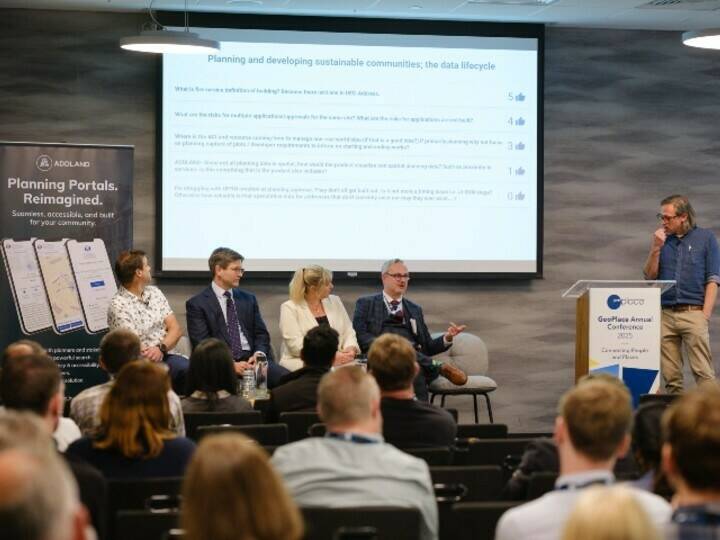Nick Chapallaz, Managing Director of GeoPlace, opened the 2025 GeoPlace Annual Conference with a warm welcome and a promise of a packed, purposeful agenda.
Recordings of the 2025 conference talks can be found here

He acknowledged the success of the previous year’s gathering in Manchester but expressed particular enthusiasm for this year’s self-contained venue, which allowed delegates to spend the day together in a focused, shared space, but with plenty of options to choose their content for the day.
The theme – Connecting People and Places – epitomises GeoPlace’s purpose, bringing location to life. Nick emphasised how powerfully this continues to express the value of work carried out by attendees across local government, central departments, the private sector, and beyond – including international guests from Malaysia.
He encouraged delegates not only to listen and enjoy the day’s sessions, but to leave with at least one idea to act on back in their organisations. GeoPlace, he stressed, was also there to celebrate the hard work and success of its community. This year marked the 20th presentation of Exemplar Awards – a milestone that predated GeoPlace’s own formation in 2011, reflecting the sustained dedication of local authorities to quality data over decades.
Nick reiterated GeoPlace’s mission: to ensure that the data developed collaboratively across the sector is widely valued and effectively used. He spoke of a future in which everyone benefits from the power of location data, and reaffirmed the importance of maintaining the highest possible quality in UPRNs and USRNs, street records, and associated reference data. For local authorities, understanding every interaction within their boundaries – buildings, transport assets, people – is fundamental. GeoPlace’s infrastructure data was described as core to this understanding: geospatial data is among the most powerful assets organisations have, second only to people.
UPRNs and USRNs, he explained, allows organisations to connect datasets about people and places in meaningful ways. Reference content underpins improved processes and better decision-making, ultimately leading to better outcomes.
Nick highlighted the NHS's federated data platform and emerging developments like the National Data Library, showing how a centralised, geospatial approach was now extending across sectors. Location reference data – including UPRNs and street asset records – was now being used to join up internal systems, improve accuracy, reduce duplication, and support innovation.
Artificial intelligence, he noted, is only as good as the data fed into it – and much of that data originates in the work being done by attendees.
Nick cited 16 million changes recorded through the GeoPlace model over the past 12 months, calling it a huge contribution. He highlighted some of the local authority presentations that would be taking place that day:
1. Tameside sharing insights into embedding UPRNs in planning to streamline data flow and service coordination
2. Lewisham using its gazetteer data to enhance asset management across departments
3. Kingston & Sutton improving pre-Census address data, leading to more accurate funding
4. Swindon’s emergency planning connecting data to support vulnerable residents
5. Reading’s demonstration of how a central GIS and data team supports services
6. Tower Hamlets work on linking school and GP data to assess the effects of free school meals on child health and education.
GeoPlace continues to invest in the infrastructure that makes this possible. The primary contributions from local authorities are being integrated with wider datasets to increase usability in broader markets. With 47.7 million UPRNs and 1.7 million streets recorded, the scale of the undertaking – and the range of attributes surrounding each data point – is considerable. But use of the data is growing across central government: in street planning and management, electoral registration, and even stamp duty land tax, where UPRNs has been incorporated into official forms. Nick described this as a ‘key registers’ approach, spreading across the commercial sector.
GeoPlace’s role is not only to maintain the data, but to help to ensure it is being used – and it is stimulating innovation. Government use of location data is, in turn, helping drive new approaches in the commercial world. Nick encouraged attendees to take full advantage of the National Geographic Database and related datasets. He showed examples of how local authorities’s own data ended up in national services and urged organisations to stop duplicating data internally. Instead, he recommended using APIs – such as OS Places – to access and integrate national geospatial data efficiently.
In terms of GeoPlace’s own services, the message was clear: use them to get value from your own data and make services more efficient. From permit schemes to traffic-sensitive reviews, local authorities have enormous potential at their fingertips. Products like FindMyAddress and FindMyStreet provide access to open data – notably the National Street Gazetteer – delivered back into organisations as a service. Both products are supported by the Local Government Association, with whom GeoPlace is pleased to be working more closely on outreach.



